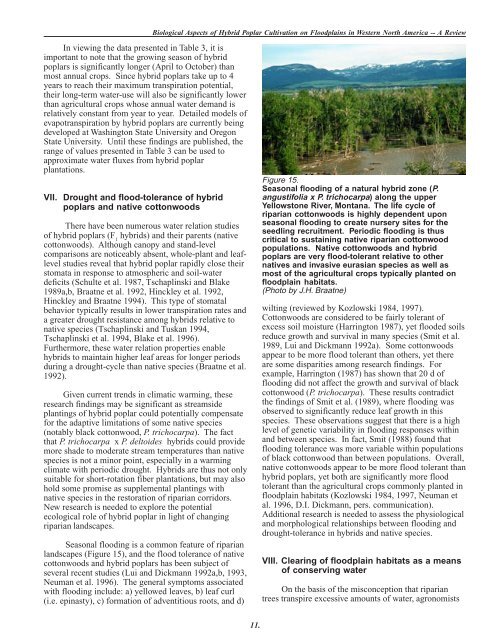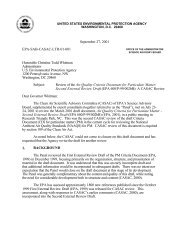Biological Aspects of Hybrid Poplar Cultivation on Floodplains in ...
Biological Aspects of Hybrid Poplar Cultivation on Floodplains in ...
Biological Aspects of Hybrid Poplar Cultivation on Floodplains in ...
Create successful ePaper yourself
Turn your PDF publications into a flip-book with our unique Google optimized e-Paper software.
<str<strong>on</strong>g>Biological</str<strong>on</strong>g> <str<strong>on</strong>g>Aspects</str<strong>on</strong>g> <str<strong>on</strong>g>of</str<strong>on</strong>g> <str<strong>on</strong>g>Hybrid</str<strong>on</strong>g> <str<strong>on</strong>g>Poplar</str<strong>on</strong>g> <str<strong>on</strong>g>Cultivati<strong>on</strong></str<strong>on</strong>g> <strong>on</strong> <strong>Floodpla<strong>in</strong>s</strong> <strong>in</strong> Western North America -- A ReviewIn view<strong>in</strong>g the data presented <strong>in</strong> Table 3, it isimportant to note that the grow<strong>in</strong>g seas<strong>on</strong> <str<strong>on</strong>g>of</str<strong>on</strong>g> hybridpoplars is significantly l<strong>on</strong>ger (April to October) thanmost annual crops. S<strong>in</strong>ce hybrid poplars take up to 4years to reach their maximum transpirati<strong>on</strong> potential,their l<strong>on</strong>g-term water-use will also be significantly lowerthan agricultural crops whose annual water demand isrelatively c<strong>on</strong>stant from year to year. Detailed models <str<strong>on</strong>g>of</str<strong>on</strong>g>evapotranspirati<strong>on</strong> by hybrid poplars are currently be<strong>in</strong>gdeveloped at Wash<strong>in</strong>gt<strong>on</strong> State University and Oreg<strong>on</strong>State University. Until these f<strong>in</strong>d<strong>in</strong>gs are published, therange <str<strong>on</strong>g>of</str<strong>on</strong>g> values presented <strong>in</strong> Table 3 can be used toapproximate water fluxes from hybrid poplarplantati<strong>on</strong>s.VII. Drought and flood-tolerance <str<strong>on</strong>g>of</str<strong>on</strong>g> hybridpoplars and native cott<strong>on</strong>woodsThere have been numerous water relati<strong>on</strong> studies<str<strong>on</strong>g>of</str<strong>on</strong>g> hybrid poplars (F 1hybrids) and their parents (nativecott<strong>on</strong>woods). Although canopy and stand-levelcomparis<strong>on</strong>s are noticeably absent, whole-plant and leaflevelstudies reveal that hybrid poplar rapidly close theirstomata <strong>in</strong> resp<strong>on</strong>se to atmospheric and soil-waterdeficits (Schulte et al. 1987, Tschapl<strong>in</strong>ski and Blake1989a,b, Braatne et al. 1992, H<strong>in</strong>ckley et al. 1992,H<strong>in</strong>ckley and Braatne 1994). This type <str<strong>on</strong>g>of</str<strong>on</strong>g> stomatalbehavior typically results <strong>in</strong> lower transpirati<strong>on</strong> rates anda greater drought resistance am<strong>on</strong>g hybrids relative t<strong>on</strong>ative species (Tschapl<strong>in</strong>ski and Tuskan 1994,Tschapl<strong>in</strong>ski et al. 1994, Blake et al. 1996).Furthermore, these water relati<strong>on</strong> properties enablehybrids to ma<strong>in</strong>ta<strong>in</strong> higher leaf areas for l<strong>on</strong>ger periodsdur<strong>in</strong>g a drought-cycle than native species (Braatne et al.1992).Given current trends <strong>in</strong> climatic warm<strong>in</strong>g, theseresearch f<strong>in</strong>d<strong>in</strong>gs may be significant as streamsideplant<strong>in</strong>gs <str<strong>on</strong>g>of</str<strong>on</strong>g> hybrid poplar could potentially compensatefor the adaptive limitati<strong>on</strong>s <str<strong>on</strong>g>of</str<strong>on</strong>g> some native species(notably black cott<strong>on</strong>wood, P. trichocarpa). The factthat P. trichocarpa x P. deltoides hybrids could providemore shade to moderate stream temperatures than nativespecies is not a m<strong>in</strong>or po<strong>in</strong>t, especially <strong>in</strong> a warm<strong>in</strong>gclimate with periodic drought. <str<strong>on</strong>g>Hybrid</str<strong>on</strong>g>s are thus not <strong>on</strong>lysuitable for short-rotati<strong>on</strong> fiber plantati<strong>on</strong>s, but may alsohold some promise as supplemental plant<strong>in</strong>gs withnative species <strong>in</strong> the restorati<strong>on</strong> <str<strong>on</strong>g>of</str<strong>on</strong>g> riparian corridors.New research is needed to explore the potentialecological role <str<strong>on</strong>g>of</str<strong>on</strong>g> hybrid poplar <strong>in</strong> light <str<strong>on</strong>g>of</str<strong>on</strong>g> chang<strong>in</strong>griparian landscapes.Seas<strong>on</strong>al flood<strong>in</strong>g is a comm<strong>on</strong> feature <str<strong>on</strong>g>of</str<strong>on</strong>g> riparianlandscapes (Figure 15), and the flood tolerance <str<strong>on</strong>g>of</str<strong>on</strong>g> nativecott<strong>on</strong>woods and hybrid poplars has been subject <str<strong>on</strong>g>of</str<strong>on</strong>g>several recent studies (Lui and Dickmann 1992a,b, 1993,Neuman et al. 1996). The general symptoms associatedwith flood<strong>in</strong>g <strong>in</strong>clude: a) yellowed leaves, b) leaf curl(i.e. ep<strong>in</strong>asty), c) formati<strong>on</strong> <str<strong>on</strong>g>of</str<strong>on</strong>g> adventitious roots, and d)Figure 15.Seas<strong>on</strong>al flood<strong>in</strong>g <str<strong>on</strong>g>of</str<strong>on</strong>g> a natural hybrid z<strong>on</strong>e (P.angustifolia x P. trichocarpa) al<strong>on</strong>g the upperYellowst<strong>on</strong>e River, M<strong>on</strong>tana. The life cycle <str<strong>on</strong>g>of</str<strong>on</strong>g>riparian cott<strong>on</strong>woods is highly dependent up<strong>on</strong>seas<strong>on</strong>al flood<strong>in</strong>g to create nursery sites for theseedl<strong>in</strong>g recruitment. Periodic flood<strong>in</strong>g is thuscritical to susta<strong>in</strong><strong>in</strong>g native riparian cott<strong>on</strong>woodpopulati<strong>on</strong>s. Native cott<strong>on</strong>woods and hybridpoplars are very flood-tolerant relative to othernatives and <strong>in</strong>vasive eurasian species as well asmost <str<strong>on</strong>g>of</str<strong>on</strong>g> the agricultural crops typically planted <strong>on</strong>floodpla<strong>in</strong> habitats.(Photo by J.H. Braatne)wilt<strong>in</strong>g (reviewed by Kozlowski 1984, 1997).Cott<strong>on</strong>woods are c<strong>on</strong>sidered to be fairly tolerant <str<strong>on</strong>g>of</str<strong>on</strong>g>excess soil moisture (Harr<strong>in</strong>gt<strong>on</strong> 1987), yet flooded soilsreduce growth and survival <strong>in</strong> many species (Smit et al.1989, Lui and Dickmann 1992a). Some cott<strong>on</strong>woodsappear to be more flood tolerant than others, yet thereare some disparities am<strong>on</strong>g research f<strong>in</strong>d<strong>in</strong>gs. Forexample, Harr<strong>in</strong>gt<strong>on</strong> (1987) has shown that 20 d <str<strong>on</strong>g>of</str<strong>on</strong>g>flood<strong>in</strong>g did not affect the growth and survival <str<strong>on</strong>g>of</str<strong>on</strong>g> blackcott<strong>on</strong>wood (P. trichocarpa). These results c<strong>on</strong>tradictthe f<strong>in</strong>d<strong>in</strong>gs <str<strong>on</strong>g>of</str<strong>on</strong>g> Smit et al. (1989), where flood<strong>in</strong>g wasobserved to significantly reduce leaf growth <strong>in</strong> thisspecies. These observati<strong>on</strong>s suggest that there is a highlevel <str<strong>on</strong>g>of</str<strong>on</strong>g> genetic variability <strong>in</strong> flood<strong>in</strong>g resp<strong>on</strong>ses with<strong>in</strong>and between species. In fact, Smit (1988) found thatflood<strong>in</strong>g tolerance was more variable with<strong>in</strong> populati<strong>on</strong>s<str<strong>on</strong>g>of</str<strong>on</strong>g> black cott<strong>on</strong>wood than between populati<strong>on</strong>s. Overall,native cott<strong>on</strong>woods appear to be more flood tolerant thanhybrid poplars, yet both are significantly more floodtolerant than the agricultural crops comm<strong>on</strong>ly planted <strong>in</strong>floodpla<strong>in</strong> habitats (Kozlowski 1984, 1997, Neuman etal. 1996, D.I. Dickmann, pers. communicati<strong>on</strong>).Additi<strong>on</strong>al research is needed to assess the physiologicaland morphological relati<strong>on</strong>ships between flood<strong>in</strong>g anddrought-tolerance <strong>in</strong> hybrids and native species.VIII. Clear<strong>in</strong>g <str<strong>on</strong>g>of</str<strong>on</strong>g> floodpla<strong>in</strong> habitats as a means<str<strong>on</strong>g>of</str<strong>on</strong>g> c<strong>on</strong>serv<strong>in</strong>g waterOn the basis <str<strong>on</strong>g>of</str<strong>on</strong>g> the misc<strong>on</strong>cepti<strong>on</strong> that ripariantrees transpire excessive amounts <str<strong>on</strong>g>of</str<strong>on</strong>g> water, agr<strong>on</strong>omists11.
















